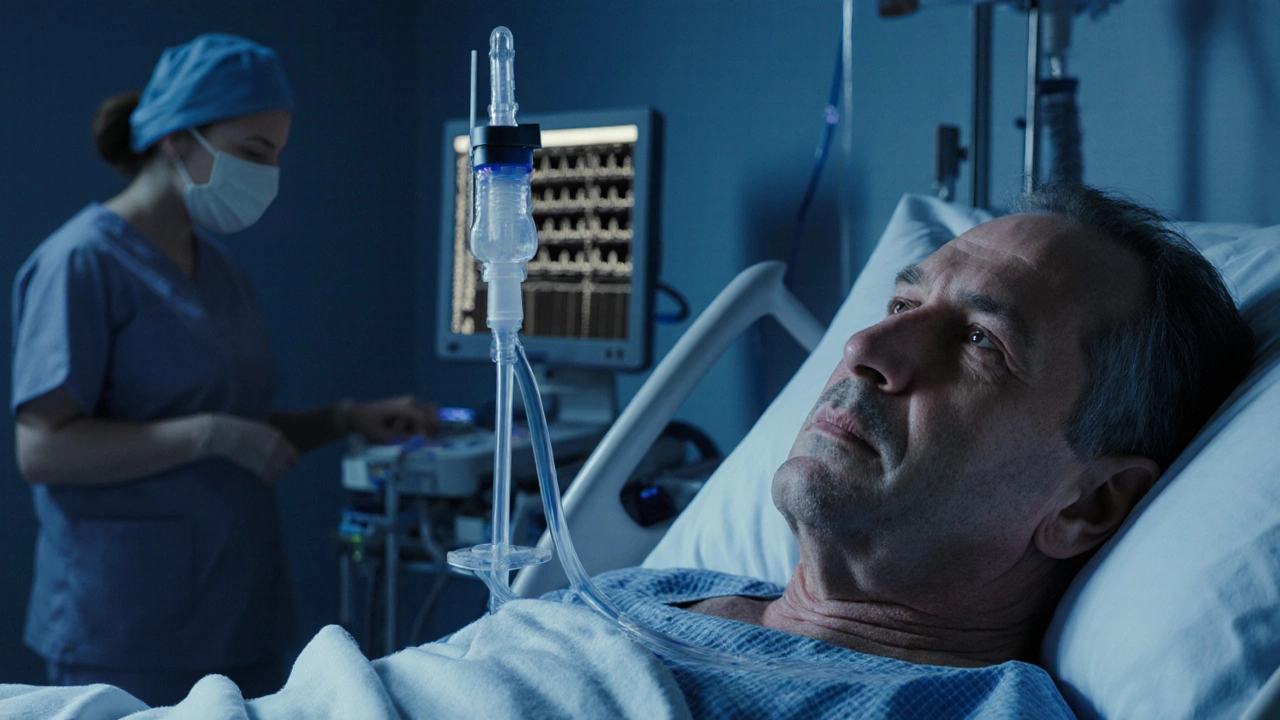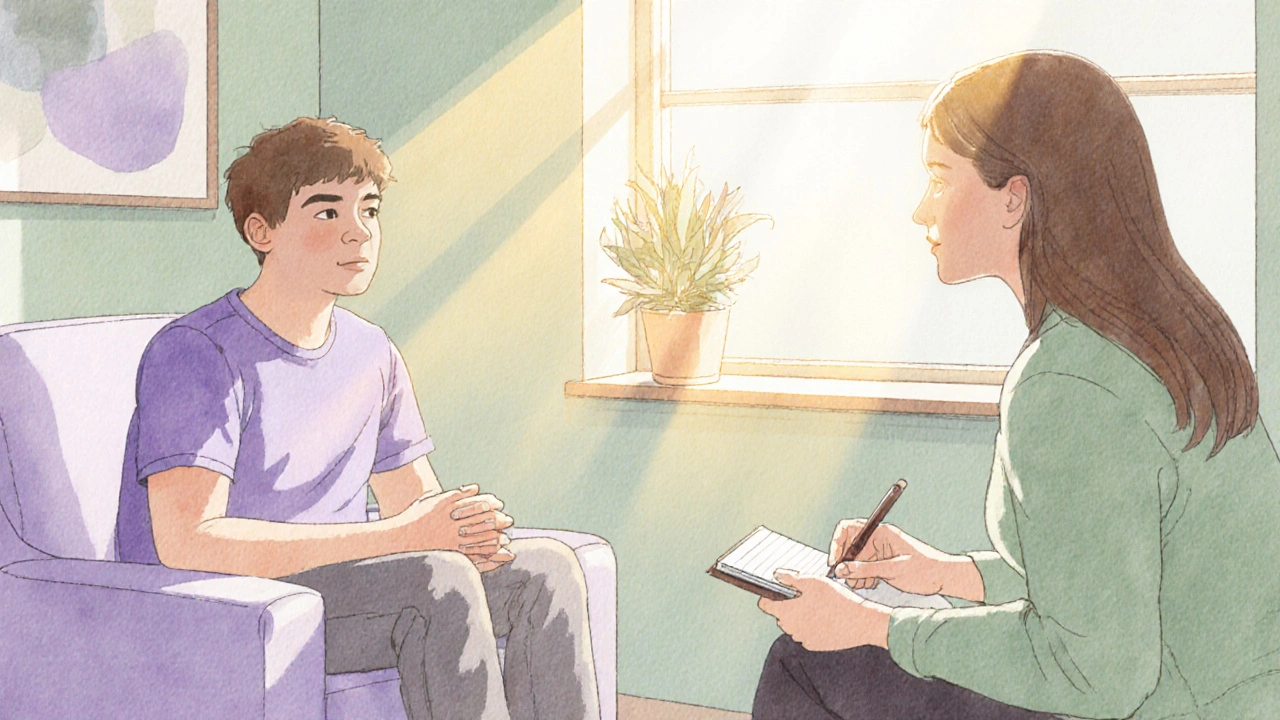
Candidemia Mental Health Risk Assessment
Your Mental Health Risk Assessment
This tool estimates your risk for anxiety, depression, and PTSD after candidemia based on clinical factors and patient history. It's not a diagnostic tool but helps identify who may need more mental health support.
Risk Assessment Results
Based on your responses, your risk level is:
0
Low risk
Key Takeaways
- Candidemia and disseminated Candida infections can trigger anxiety, depression, and PTSD, often lasting months after hospital discharge.
- Patients with prolonged ICU stays, organ failure, or invasive devices are at highest psychological risk.
- Early mental‑health screening, multidisciplinary follow‑up, and tailored counseling improve long‑term quality of life.
- Antifungal drugs themselves may contribute to mood changes, so medication reviews are essential.
- Family support, peer groups, and survivorship programs reduce isolation and boost recovery.
Imagine surviving a life‑threatening bloodstream infection, only to find the hardest part begins after the IV line is removed. That’s the reality for many people hit by candidemia mental health challenges. While doctors focus on clearing the fungus, patients often wrestle with panic, low mood, and intrusive memories that linger long after the infection clears.
What Exactly Is Candidemia?
Candidemia is a bloodstream infection caused by Candida species, most commonly Candida albicans. It typically spreads from skin, gastrointestinal or urinary sources into the bloodstream, leading to systemic inflammation and organ dysfunction.
When the fungus spreads beyond the blood to multiple organs, clinicians call it disseminated Candida infection. This form can involve the liver, spleen, kidneys, eyes, and even the brain, dramatically raising mortality rates.
Why Mental Health Is Part of the Equation
Severe infections trigger a cascade of physiological stress: high fevers, cytokine storms, and the shock of being in intensive care. Those physical assaults are mirrored by psychological blows-loss of control, invasive procedures, and the looming threat of death. Studies from 2022‑2024 show that up to 45% of candidemia survivors report clinically significant anxiety, while 38% meet criteria for depression within three months of discharge.
These numbers are not random; they echo findings for other sepsis survivors, but candidemia adds unique layers. The fungus can invade the central nervous system, sometimes causing subtle neuro‑cognitive deficits that fuel frustration and hopelessness.

Risk Factors That Heighten Psychological Impact
- Prolonged ICU stay: More than two weeks in the ICU correlates with a 60% rise in PTSD symptoms.
- Organ failure: Patients on dialysis or ventilators report higher anxiety scores.
- Invasive devices: Central lines or urinary catheters increase infection severity and sense of vulnerability.
- Pre‑existing mental health conditions: History of depression or anxiety doubles the risk of post‑infection mood disorders.
- Age and gender: Women under 60 and older adults over 75 show distinct patterns of depressive and anxiety symptoms.
How the Infection Itself Can Influence Mood
The fungus releases metabolites that can cross the blood‑brain barrier, subtly altering neurotransmitter balance. While research is still emerging, preliminary animal models suggest Candida can affect serotonin pathways, potentially explaining mood swings during and after treatment.
Moreover, antifungal therapy (especially echinocandins and high‑dose fluconazole)
can produce side effects like nausea, hepatotoxicity, and fatigue-all of which may worsen depressive outlooks. A 2023 multi‑center trial noted that 12% of patients on prolonged echinocandin therapy experienced new‑onset anxiety, underscoring the need for medication‑related mental health monitoring.Screening and Early Detection
Integrating mental‑health screening into the discharge checklist has proven cost‑effective. The Hospital Anxiety and Depression Scale (HADS) and the Impact of Event Scale‑Revised (IES‑R) are quick tools that can be administered bedside or via telehealth within 48hours of leaving the hospital.
Key questions to ask:
- Do you feel unusually scared or on edge when you think about the hospital stay?
- Have you lost interest in activities you used to enjoy?
- Are you experiencing intrusive memories or nightmares about the infection?
Positive screens should trigger a referral to a mental‑health professional experienced with medical trauma.
Intervention Strategies That Work
Evidence‑based approaches blend pharmacologic and psychosocial tactics:
- Psychotherapy: Cognitive‑behavioral therapy (CBT) reduces anxiety scores by an average of 8 points on the HADS in post‑sepsis cohorts.
- Medication review: Adjusting antifungal regimens to the shortest effective course can alleviate drug‑related mood disturbances.
- Peer support groups: Survivorship programs for fungal infections reported a 30% drop in self‑reported isolation.
- Physical rehabilitation: Exercise improves serotonin levels and helps rebuild confidence after prolonged bed rest.
- Family involvement: Educating caregivers on warning signs reduces delayed help‑seeking by 25%.

Long‑Term Outlook and Quality of Life
Even when the infection clears, many patients face lingering fatigue, memory lapses, and mood fluctuations. A five‑year follow‑up of 400 candidemia survivors in Australia showed that 22% still required mental‑health medications, and 18% reported reduced work productivity.
However, proactive follow‑up changes the story. Clinics that combine infectious disease follow‑up with psychology services see a 40% improvement in quality‑of‑life scores (SF‑36) after one year.
Practical Checklist for Patients and Providers
| Step | Who’s Responsible | What to Do |
|---|---|---|
| 1 | Infectious disease team | Document antifungal regimen and potential neuro‑psychiatric side effects. |
| 2 | ICU nurse | Administer HADS screening before discharge. |
| 3 | Primary care physician | Schedule follow‑up mental‑health appointment within two weeks. |
| 4 | Patient / Family | Track mood changes in a journal; note any new anxiety or intrusive thoughts. |
| 5 | Psychologist or psychiatrist | Initiate CBT or medication if screening is positive. |
| 6 | Rehabilitation therapist | Design a gradual exercise plan to boost energy and mood. |
Looking Ahead: Research Gaps and Future Directions
While we know the psychological fallout is real, many questions linger:
- Which Candida species cause the most neuro‑cognitive impact?
- Can early probiotic therapy modulate CNS inflammation?
- What is the optimal duration of antifungal treatment to minimize mood side effects?
Large‑scale longitudinal studies and randomized trials of integrated care models are needed to refine guidelines.
Frequently Asked Questions
Can candidemia cause lasting brain damage?
In rare cases, disseminated Candida can invade the brain, leading to meningitis or focal lesions. Most survivors experience subtle cognitive changes-poor concentration, memory lapses-rather than permanent structural damage. Early neuro‑cognitive testing helps identify those who need rehab services.
How soon should I talk to a mental‑health professional after the infection?
If screening tools flag anxiety or depression before discharge, arrange a referral within 48hours. Even if screens are negative, schedule a follow‑up visit at four weeks to reassess, as symptoms often emerge after patients return home.
Do antifungal drugs themselves make me feel depressed?
Some antifungals, especially high‑dose echinocandins, have been linked to anxiety and mood swings in a minority of patients. Your doctor can adjust the dose, switch to a different class, or add a short‑term mood‑stabilizer if needed.
What lifestyle changes help my recovery?
Gentle aerobic activity, balanced nutrition, and consistent sleep patterns all support brain chemistry. Avoid alcohol and excessive caffeine, which can worsen anxiety. Connecting with a support group for infection survivors also reduces feelings of isolation.
Is there a genetic reason why some people develop depression after candidemia?
Research suggests variations in the serotonin transporter gene (5‑HTTLPR) may increase susceptibility to post‑infection mood disorders, but genetics is only one piece of the puzzle. Environmental stressors and the severity of the infection play larger roles.

 Health and Wellness
Health and Wellness
Taryn Bader
October 14, 2025 AT 15:30This hits close to home.
Myra Aguirre
October 15, 2025 AT 19:33Candidemia can be a scary experience, especially when you end up in the ICU for weeks.
The lingering anxiety after discharge is something many patients overlook.
It’s important to have a solid support system once you’re home.
Shawn Towner
October 16, 2025 AT 23:37One could argue that the mental‑health scores attached to candidemia are a bit overblown; the data often mixes transient stress with chronic conditions.
Sure, the infection is serious, but not every survivor will develop PTSD.
We need to separate the physiological trauma from the psychological aftermath.
Ujjwal prakash
October 18, 2025 AT 03:40Honestly, Shawn, your point misses the bigger picture!
Studies consistently show a spike in anxiety and depressive symptoms after prolonged ICU stays, especially when invasive devices are involved.
It’s not just a fleeting stress response; we’re talking about neuro‑inflammatory pathways that can alter mood regulation.
Dismissal of these findings can leave patients without the care they truly need.
Cindy Knox
October 19, 2025 AT 07:43I felt the weight of uncertainty when I was recovering from a bloodstream infection.
Even simple things like getting out of bed felt monumental.
Having a clear risk‑assessment tool can give patients something concrete to hold onto.
beverly judge
October 20, 2025 AT 09:00That’s why it’s crucial for clinicians to follow up with mental‑health referrals as soon as possible.
Early intervention can prevent the spiral into chronic depression.
Patients often don’t ask for help, so we need to ask for them.
Capt Jack Sparrow
October 21, 2025 AT 13:03From a clinical standpoint, the risk calculator is a handy adjunct.
It pulls together ICU duration, organ involvement, and pre‑existing conditions into a single score.
Doctors can use that number to flag high‑risk patients for psychiatry consults.
Jesse Groenendaal
October 22, 2025 AT 17:07People love to dramatize every ICU stay, but not every case leads to lifelong trauma.
Persephone McNair
October 23, 2025 AT 21:10While the anecdotal “drama” is noted, the epidemiological data indicates a 22% prevalence of post‑ICU PTSD among candidemia survivors.
Standardized screening tools are therefore not just optional-they’re essential for evidence‑based care.
Skipping this step undermines both patient outcomes and healthcare quality metrics.
siddharth singh
October 25, 2025 AT 01:13When a patient battles candidemia, the physiological insult is only the tip of the iceberg.
First, the invasive devices-central lines, urinary catheters, ventilators-serve as portals for the fungus, but they also create a sense of vulnerability that persists long after removal.
Second, the prolonged ICU stay disrupts normal circadian rhythms, leading to sleep deprivation that impairs emotional regulation.
Third, systemic inflammation releases cytokines that can cross the blood‑brain barrier, influencing neurotransmitter pathways associated with mood.
Fourth, the experience of being critically ill often triggers a loss of personal control, a known predictor for anxiety disorders.
Fifth, if the patient already has a history of depression or anxiety, the added stress of a life‑threatening infection can exacerbate those conditions dramatically.
Sixth, age plays a role; older adults may experience a steeper decline in resilience, making them more susceptible to post‑traumatic stress.
Seventh, gender differences have been observed, with females showing higher rates of post‑ICU depression, possibly due to hormonal and psychosocial factors.
Eighth, the social context after discharge matters-a lack of family support or financial strain can hinder recovery.
Ninth, the stigma attached to severe infections can lead to social isolation, further deteriorating mental health.
Tenth, the cumulative effect of these factors often manifests as a triad of anxiety, depression, and PTSD, which, if untreated, can impair functional outcomes for months or even years.
Eleventh, early identification through tools like the presented risk calculator enables clinicians to intervene with psychotherapy, pharmacologic treatment, or both.
Twelfth, multidisciplinary teams that include mental‑health professionals have been shown to improve quality‑adjusted life years in this population.
Thirteenth, patient education about the potential psychological sequelae normalizes the experience and reduces shame.
Fourteenth, follow‑up appointments that specifically address mental health can catch emerging symptoms before they become entrenched.
Fifteenth, ultimately, treating candidemia is not just about eradicating the fungus; it’s about restoring the whole person, mind and body alike.
Angela Green
October 26, 2025 AT 05:17Great detail, Siddharth, but watch your comma splices.
April Malley
October 27, 2025 AT 09:20I agree with Angela-clear punctuation helps readers follow the argument without getting lost.
scott bradshaw
October 28, 2025 AT 13:23Honestly, if we spend more time building calculators than actually treating infections, we’re missing the point.
Focus on getting the fungus out first, then worry about the “risk scores”.